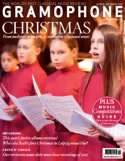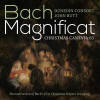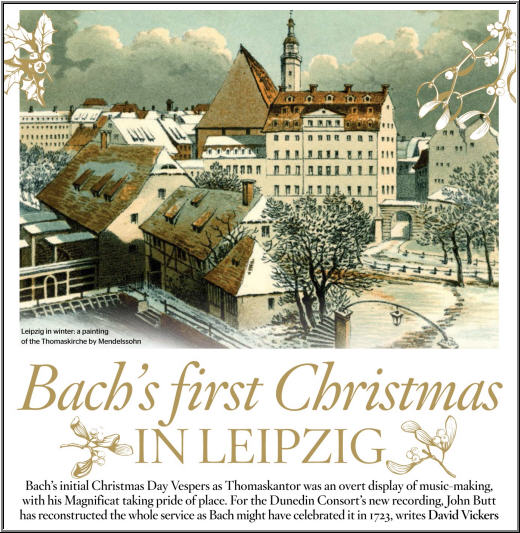Texte paru dans: / Appeared in: |
|
|
Outil de traduction (Très approximatif) |
|
|
There have been eminent recordings of Bach’s Magnificat, whether big or small or all sorts of shapes and sizes in between, but as I sit at the back of Edinburgh’s historic Greyfriars Kirk on a gloriously sun-drenched July evening it becomes apparent that John Butt and the Dunedin Consort are in the midst of producing a barnstormer. There are beaming smiles from the musicians – and after the final strains of the Magnificat are safely in the can, Linn’s Producer Philip Hobbs is unable to control his excitement. ‘Sometimes I have to pinch myself to remember I’m actually getting paid to do this,’ he tells me. ‘It’s just such incredibly fantastic music!’ During the sessions I repeatedly overhear players and singers expressing similar astonishment at their good fortune in participating in such special music-making. The vocation of a musician can be a thankless task, but days like this seem to remind the Dunedin Consort of why they wanted to pursue their chosen profession.
Bach would have understood better than anyone that the career of a musician has its challenges. After a few years of working happily as the Kapellmeister at the court of Prince Leopold of Anhalt-Cöthen, it seems that things took a turn for the worse when the Prince’s new wife was not keen on her husband’s passion for music (Bach later described her to a friend as ‘eine Amusa’ – someone immune to the Muses), and this coincided with Leopold’s funds being drained by increased contributions to the Prussian military. Moreover, for some years Bach had had no opportunity to perform concerted music in church services because the court chapel at Cöthen was strictly Calvinist; this must have been unfulfilling for such a supreme organist and gifted composer of sacred vocal pieces who had become accustomed to writing this sort of music for liturgical use in Mühlhausen (1707-8) and Weimar (1708-17). In such a light, it is not surprising that in December 1722 Bach applied for the position of Thomaskantor in Leipzig, a job that required its occupant to be church organist, choirmaster and composer at the city’s Thomaskirche, teacher at its associated school next door, and also to lead musical life at the city’s three other main churches. In many senses, the role of Thomaskantor was not dissimilar from being the municipal director of music for the imperial free town; Leipzig was the home of a prestigious university and a thriving centre of mercantile trades, reputedly larger than the kingdom of Saxony’s capital city Dresden.
The drawn-out selection process took many months. The Thomaskantor Kuhnau died in June 1722, and two months later the town council offered the job to the former Leipzig law student Telemann, who had only recently settled in Hamburg and mulled over the offer for three months before declining it politely (it helped that the Hamburg authorities gave him a pay rise). Next, the comparably talented Fasch declined the position, and so did the Thomaskirche alumnus Graupner, who could not extricate himself from his employment for the Landgrave of HessenDarmstadt. Bach had no such difficulties in being released amicably by Prince Leopold, who provided a glowing reference. On April 19, Bach pledged that he would instruct the schoolboys ‘not only in the regular classes…but also, without special compensation, in private singing lessons’, and also accepted that he would pay out of his own pocket for any assistance he might require if ‘someone should be needed to assist me in the instruction of Latin’. Three days later the Leipzig authorities voted unanimously in favour of appointing Bach, and the minutes recorded that town councillor Dr Steger hoped Bach ‘should make compositions that were not theatrical.’
Christmas in Leipzig in 1723 would have been rather chillier and a good deal less comfortable for Bach’s hard-worked musicians than the balmy summer conditions that greet me in Edinburgh when I arrive for the start of the Dunedin Consort’s first session. ‘We’ve already got one aria in the can!’ John Butt tells me. Philip Hobbs and Assistant Engineer Robert Cammidge set up and balanced the microphones during that morning’s rehearsal, and it went so smoothly that they’ve started recording already. The Magnificat is only just over half an hour long, even in its original E flat version with extra antiphons, but there is still a lot of music to cram into these sessions. Butt already knows that there’s slightly too much music to fit on a single CD. ‘There’ll be a few little bits like some extra organ preludes, one of the hymns, the responsory, collect and blessing that we’ll make available as free downloads for people who want to hear the full liturgy – although we’re not going to include an optional sermon in German, like we did with our John Passion Vespers!’
Butt himself is playing six of Bach’s chorale preludes on the Greyfriars organ, and these formulate a vivid sense of drama. The first vocal music in Bach’s Vespers, Butt tells me, would have been a motet, ‘sung by the first “Cantorey” of the Thomasschule’s eight most advanced specialists, who were trained to sing double-choir motets. I’ve chosen Gabrieli’s Hodie Christus natus est, one of the motets printed in Erhard Bodenschatz’s Florilegium Portense, a two-volume collection that was used by Lutheran choirmasters. Obviously we’re doing it in a Bachian way rather than in the earlier 17th-century Venetian style, so that means no sackbuts, cornetti or theorbos, but only a continuo group of cello, violone and organ on the bass line.’ The little Gabrieli motet remains glorious in its Bachian garb, but after the last cadence ebbs away Hobbs is already rushing in to reposition the double choir line-up; he separates the singers, initially standing in a single row, so there is now about eight feet between the two quartets, and he also adjusts the microphones to capture a clearer sense of antiphonal separation. It requires a few takes for everything to gel but everyone is buzzing at singing some Gabrieli.
Later in the week, an invited congregational choir will assemble at Greyfriars Kirk to record three hymns, with organist Stephen Farr providing Bachian embellishments between the verses; two of these are popular Lutheran Christmas hymn tunes, Vom Himmel hoch and Puer natus in Bethlehem, using harmonisations from Gottfried Vopelius’s Neu Leipziger Gesangbuch (1682) – a hymnbook still in circulation in Bach’s time. As the sessions are running happily ahead of schedule, Butt decides spontaneously to record selected verses from these hymns to be sung by the Dunedin Consort in four-part harmony (the congregation will supply the remaining verses in unison). Coming at the end of a long day’s work, it breaks down into laughter a few times, but before turning in for the night the session finishes with Nicholas Mulroy stepping up to perform the function of a celebrant invoking a series of choral responses. Hearing these being worked on by performers who not many minutes ago were refining the grand trumpet-laden climax to the Magnificat shows in a nutshell the wide contrasts of musical texture, style and scale that were all part of Bach’s liturgical music-making. His Leipzig predecessors had already created church music featuring instruments and solo voices since the 17th century, but the new Thomaskantor created an astonishing corpus of distinctively characterised works on an almost weekly basis during his first few years in the job, drawing influences from recent musical styles imported from Italy and France and fusing them within his own unique compositional voice. Accordingly, the simpler hymns and responses not only show how singing and music operated on different levels during Lutheran services but also how the interjection of Bach’s elaborate concerted music must have had a powerful dramatic impact within the liturgy. Butt agrees: ‘When we hear it alongside the archaic chant and responses, the startling modernity and theatrical colours of Bach’s music emerge really clearly.’
The boldest possible impact of Bach’s largest-scale music is to the fore in sessions devoted to Christen, ätzet diesen tag. Bach’s only cantata featuring four trumpets is structured as a mirror-image chiasmus, and the triple-time opening chorus and exuberant closing chorus ‘Höchster, schau in Gnaden an’ both fizz with excitement in the rapid-moving strings and three oboes, with plenty of booming splendour from the quartet of trumpets and timpani – all of whom are clearly having the time of their lives. Third trumpeter Michael Harrison confides that he has now recorded it five times and that it’s still one of his favourite Bach cantatas. Butt asks the eight-strong chorus to chant the text first in order to get the rhythmic and syllabic stresses just right so that they can properly articulate the words before they sing them. At one stage with the opening chorus, Butt throws caution to the wind and says, ‘Let’s try a ridiculously fast version, just to see what it’s like!’ Far from being rushed, it feels more eloquent, shapely and relaxed; there are crisper words and more relaxed gestural details from the eight singers, whose intricate contrapuntal parts are like an animated conversation.
Bach delivers plenty more knock-out blows in the Magnificat, the canticle from St Luke’s gospel recounting the elated song of the pregnant Mary during her visit to her also-pregnant cousin Elizabeth. All Vespers services in Bach’s time featured the canticle text sung or recited in one form or another, but the concerted music performed on Christmas Day 1723 must have struck the Leipzig congregation as extraordinary. The stile antico fugue ‘Sicut locutus est’ and its transition into the doxology ‘Gloria Patri et Filio’ is routinely a fulsome moment in larger-scale performances, but the Dunedin Consort’s 10 supremely capable singers create an enthralling ebb and flow in the unaccompanied upward-melismatic sequences that Bach creates upon reaching the word ‘Gloria’. In the extraordinary harmonic climax to this section, Butt’s sheer mastery of Bach’s layered sonorities hits me right in the solar plexus – and then there’s the sucker punch when the wind and brass kick in on those glorious cadences. The transparency of sonorities is a vivid characteristic of Butt’s approach to Bach’s original E flat version of the Magnificat, and he explains this is helped by choosing low pitch for the strings and woodwind (A = 392Hz, known in Bach’s time as tiefKammerton), although the trumpets are actually playing at higher pitch (A = 415) in D major: ‘This mixture of instruments playing at different pitches was common for Bach in Weimar, Cöthen and perhaps in his earliest years in Leipzig; the heavier string gauges and slightly larger woodwind instruments mean we can explore richer sonorities at the lower pitch.’
There are several differences between this early version of the Magnificat and the more familiar revised version in D major that Bach prepared during the early 1730s. The alto aria ‘Esurientes’, sung with a lightness of touch by Clare Wilkinson, has a pair of recorders (in the later version Bach changed them to transverse flutes). It’s beguiling stuff – at the aria’s conclusion you can hear a pin drop, although one of the takes is interrupted by Hobbs, who says: ‘Clare – just a bit of a frog in the throat in your first entry…’, to which the good-humoured Butt instantly responds, ‘Only a tadpole, surely!’ Another subtle difference is the slide trumpet playing the tonus peregrinus (instead of oboe) in the trio ‘Suscepit Israel’; the airy refinement of the weightless upper strings, without basso continuo roots, is matched by Wilkinson, Julia Doyle and Joanne Lunn, but it is visibly hard, physical work for Paul Sharp to control the notoriously fiendish slide trumpet. It is well worth the effort as his efforts to contribute soft, long-held notes result in a spellbinding texture.
The most obvious distinction from the more familiar, later version of the Magnificat is four additional Christmas-related antiphons. In Bach’s manuscript these pages are inserted at the end after the Magnificat, which prompts speculation from scholars that maybe they were festive additions incorporated into a score that had already been composed and performed earlier on in 1723, perhaps for the Feast of Visitation on July 2. Butt requests that the four-part choir and doubling woodwind and strings strive to be ‘more cheerful and bell-like’ when they record the first antiphon Vom Himmel hoch. The second interpolation is Freut euch und jubiliert, a succinct little piece for two sopranos (which Butt doubles with oboes), alto, tenor and simple continuo, full of tricky details and florid word-painting not far removed from Bach’s more extensive motets. In contrast, the third antiphon, Gloria in excelsis Deo, is a simple homophonic setting that proves to be a doddle to get in the can. The fourth and last additional antiphon is Virga Jesse floruit, a duet for soprano Julia Doyle and bass Matthew Brook, accompanied only by basso continuo.
It is fascinating to observe the collective joviality and concentration that ensures none of the familiar Magnificat movements are merely formulaic. When the choir’s tuning at a chromatic crunch point in ‘Omnes gentes’ needs to be rehearsed slowly a few times and there is a small risk of energy seeping from the session, Hobbs announces wittily: ‘I could do with a bit more from the tenors – there’s a first time for everything!’ Joanne Lunn sings radiantly during the recording of ‘Et exultavit’, and is accompanied by refined chiaroscuro phrasing from the strings; there is a refreshingly happy character to her contoured long phrases, but at one point she runs out of breath, laughs, and apologises; some conductors might tut irritably at such lapses, but this only sustains the amiable atmosphere of the session. There is also warmly jocular singing from Matthew Brook in ‘Quia fecit mihi magnam’, matched by basso continuo (including bassoon) that brims with personality, although after the first take Brook wonders if the instrumentalists were a little bit overly keen to reach the quick semiquavers, and so they try again but this time with more air and space in the bass-line figurations. Nicholas Mulroy sings ‘Deposuit potentes’ with proclamatory vigour while the violins play at the lowest end of their range with muscular flexibility, but the conductor is not yet happy with the opening ritornello and encourages the violins and bass line (cello and violone) to initiate more conversational exchanges. Bach’s interest in Vivaldi and recent Italian music is invoked in Wilkinson and Mulroy’s hushed lullaby-like ‘Et misericordia’, supported by intelligently articulated strings, and also in Julia Doyle’s rapturous dialogue with Alexandra Bellamy’s melancholic oboe in ‘Quia respexit’.
Such moments of introspective beauty and intimacy are vital ingredients in the Dunedin Consort’s celebration of Bach’s kaleidoscopic festive music – music that transformed church life beyond recognition in 18th-century Leipzig. David Vickers |
|
|
|
|
|
Cliquez l'un ou l'autre
bouton pour découvrir bien d'autres critiques de CD |
|





